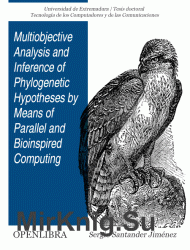
Название: Multiobjective Analysis and Inference of Phylogenetic Hypotheses by Means of Parallel and Bioinspired Computing
Автор: Sergio Santander Jim?nez
Издательство: Universidad de Extremadura
Год: 2015
Формат: pdf
Страниц: 271
Размер: 10,3 mb.
Язык: English
One of the most outstanding research topics in the field of bioinformatics is the reconstruction of evolutionary relationships among species. By studying the molecular features of living organisms, phylogenetic inference procedures seek to provide hypotheses about the evolutionary events which led to the current biodiversity in nature. The result of a phylogenetic analysis is given by a treeshaped data structure known as phylogenetic tree, whose topology describes the evolutionary history of the input species by defining ancestor-descendant relationships. The biological quality of the inferred phylogenies is usually evaluated by means of optimality criteria, which allow the modelling of phylogenetic inference as an optimization problem.
In this context, several key problems must be addressed. Firstly, the reconstruction of optimal solutions implies the processing of a search space whose size grows exponentially with the number of species under study. Additional difficulties are given by the fact that evaluation procedures require complex computations whose number grows linearly with the length of the input molecular sequences. A more controversial problem lies on the choice of the preferred optimality criterion, as it represents one of the most troublesome sources of conflict in phylogenetics. Situations where different optimality criteria give support to conflicting evolutionary histories for a given dataset can be solved by proposing a compromise view of phylogenetics based on multiobjective optimization.
This PhD Thesis aims to apply bioinspired computing to perform real phylogenetic analyses according to the maximum parsimony and maximum likelihood criteria. Such goal requires a multiobjective formulation of the problem which considers the optimization of both objective functions simultaneously, in such a way that the output of the procedure will be given not by a single solution, but a set of multiobjective phylogenetic trees which represent good compromises between divergent criteria. The implications of performing multiobjective phylogenetic analyses have not been fully evaluated in the literature, so this research seeks to carry out comprehensive comparative studies among different multiobjective algorithms, in order to decide which algorithmic designs maximize the quality of the inferred trees from a multiobjective and biological point of view.